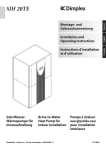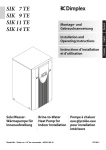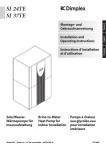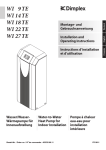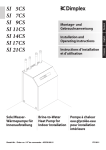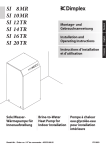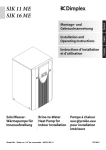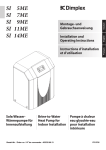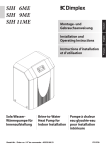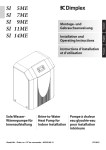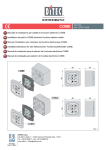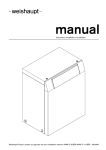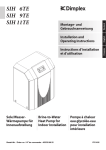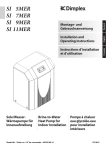Download Dimplex SI 21TE Operating instructions
Transcript
Sole/WasserWärmepumpe für Innenaufstellung Installation and Operating Instructions English Instructions d’installation et d’utilisation Français Montage- und Gebrauchsanweisung Brine-to-Water Heat Pump for Indoor Installation Bestell-Nr. / Order no. / No de commande : 452232.66.12 Deutsch SI 5TE SI 7TE SI 9TE SI 11TE SI 14TE SI 17TE SI 21TE Pompe à chaleur eau glycolée-eau pour installation intérieure FD 8611 Table of contents 1 Please Read Immediately .............................................................................................................E-2 1.1 Important Information.............................................................................................................................. E-2 1.2 Legal Regulations and Directives ........................................................................................................... E-2 1.3 Energy-Efficient Use of the Heat Pump .................................................................................................. E-2 2 Purpose of the Heat Pump ...........................................................................................................E-3 3 Basic Device ..................................................................................................................................E-3 4 Accessories ...................................................................................................................................E-4 4.1 Brine Circuit Manifold.............................................................................................................................. E-4 5 Transport........................................................................................................................................E-4 6 Set-up .............................................................................................................................................E-4 6.1 General Information ................................................................................................................................ E-4 6.2 Acoustic Emissions................................................................................................................................. E-4 7 Installation .....................................................................................................................................E-5 7.1 7.2 7.3 7.4 8 General Information ................................................................................................................................ E-5 Heating System Connection ................................................................................................................... E-5 Heat Source Connection......................................................................................................................... E-5 Electrical Connection .............................................................................................................................. E-5 Commissioning .............................................................................................................................E-6 8.1 General Information ................................................................................................................................ E-6 8.2 Preparation ............................................................................................................................................. E-6 8.3 Start-up Procedure ................................................................................................................................. E-6 9 Maintenance and Cleaning ...........................................................................................................E-7 9.1 Maintenance ........................................................................................................................................... E-7 9.2 Cleaning the Heating System ................................................................................................................. E-7 9.3 Cleaning the Heat Source System.......................................................................................................... E-7 10 Faults / Trouble-Shooting .............................................................................................................E-7 11 Decommissioning / Disposal .......................................................................................................E-7 12 Device Information ........................................................................................................................E-8 Anhang / Appendix / Annexes ............................................................................................................ A-I www.dimplex.de E-1 English 2.1 Application .............................................................................................................................................. E-3 2.2 Operating Principle ................................................................................................................................. E-3 1 1 Please Read Immediately 1.1 Important Information ATTENTION! The heat pump is not secured to the wooden pallet. ATTENTION! The heat pump must not be tilted more than 45° (in any direction). English ATTENTION! Do not use the holes in the panel assemblies for lifting the device! ATTENTION! Flush the heating system prior to connecting the heat pump. ATTENTION! The supplied dirt trap must be inserted in the heat source inlet of the heat pump to protect the evaporator against the ingress of impurities. ATTENTION! The brine solution must contain at least a 25 % concentration of a monoethylene glycol or propylene glycol-based antifreeze, which must be mixed before filling. ATTENTION! Observe the clockwise rotating field when connecting the mains cable (if rotating field is not clockwise, the heat pump will not work properly and will be very noisy). ATTENTION! The heat pump must be started up in accordance with the installation and operating instructions of the heat pump controller. ATTENTION! We recommend the installation of a suitable corrosion protection system to prevent the formation of deposits (e.g. rust) in the condenser of the heat pump. ATTENTION! Any work on the heat pump may only be performed by authorised and qualified after-sales service technicians. ATTENTION! Disconnect all electrical circuits from the power source prior to opening the device. E-2 1.2 Legal Regulations and Directives This heat pump conforms to all relevant DIN/VDE regulations and EU directives. Refer to the EC Declaration of Conformity in the appendix for details. The heat pump must be connected to the power supply in compliance with all relevant VDE, EN and IEC standards. Any further connection requirements stipulated by local utility companies must also be observed. The heat pump is to be connected to the heat source system and the heating system in accordance with all applicable regulations. Persons, especially children, who are not capable of operating the device safely due to their physical, sensory or mental abilities or their inexperience or lack of knowledge, must not operate this device without supervision or instruction by the person in charge. Children must be supervised to ensure that they do not play with the device. 1.3 Energy-Efficient Use of the Heat Pump By operating this heat pump you are helping to protect our environment. Both the heating system and the heat source must be properly designed and dimensioned to ensure efficient operation. It is particularly important to keep water flow temperatures as low as possible. All connected energy consumers should therefore be suitable for low flow temperatures. Raising the heating water temperature by 1 K corresponds to an increase in energy consumption of approx. 2.5 %. Low-temperature heating systems with flow temperatures between 30 °C and 50 °C are particularly well-suited for energyefficient operation. 3 2.1 Purpose of the Heat Pump Application The brine-to-water heat pump is designed for use in existing or newly built heating systems. Brine is used as the heat carrier in the heat source system. Borehole heat exchangers, ground heat collectors or similar systems can be used as the heat source. 2.2 Operating Principle The heat generated by the sun, wind and rain is stored in the ground. This heat stored in the ground is collected at a low temperature by the brine circulating in the ground collector, ground coil or similar device. A circulating pump then conveys the “heated” brine to the evaporator of the heat pump. There the heat is given off to the refrigerant in the refrigerating cycle. This cools the brine so that it can once again absorb thermal energy in the brine circuit. 3 Basic Device The basic device consists of a ready-to-use heat pump for indoor installation, complete with sheet metal casing, control panel and integrated controller. The refrigerating cycle contains the refrigerant R407C. R407C refrigerant is CFC-free, non-ozone depleting and non-combustible. All components required for the operation of the heat pump are located on the control panel. An external wall temperature sensor including fixing accessories and a dirt trap are supplied with the heat pump. The power feed for the load current and the control current must be installed by the customer. The supply lead of the brine circulating pump (to be provided by the customer) must be connected to the control panel. If required, the supply lead of the brine pump is be equipped with a motor protection device. The customer must provide both the collector and the brine circuit manifold. The refrigerant is drawn in by the electrically driven compressor, compressed and “pumped” to a higher temperature level. The electrical power needed to run the compressor is not lost in this process. Most of it is absorbed by the refrigerant. Subsequently, the refrigerant is passed through the condenser where it transfers its heat energy to the heating water. Depending on the set operating point (thermostat setting), the heating water is thus heated up to a max. of 60 °C. www.dimplex.de 1) Liquifier 2) Control panel 3) Evaporator 4) Compressor E-3 English 2 4 4 Accessories 4.1 Brine Circuit Manifold The brine circuit manifold merges the individual collector loops of the heat source system into a single main pipe which is connected to the heat pump. Integrated ball valves allow the individual brine circuits to be shut off for de-aeration purposes. 6 6.1 Set-up General Information The unit may only be installed indoors in rooms with low humidity on a level, smooth and horizontal surface. The entire base of the frame should lie directly on the floor to ensure a good soundproof seal. If this is not the case, additional sound insulation measures may be necessary. English The heat pump must be installed so that maintenance work can be carried out without hindrance. This can be ensured by maintaining a clearance of approx. 1 m in front of and on each side of the heat pump. 5 Transport A lift truck is suited for transporting the unit on a level surface. Carrying straps may be used if the heat pump needs to be transported on an uneven surface or carried up or down stairs. These straps can be passed directly underneath the wooden pallet. ATTENTION! The heat pump is not secured to the wooden pallet. ATTENTION! The heat pump must not be tilted more than 45° (in any direction). Use the holes provided in the sides of the frame to lift the unit without the pallet. The side panel assemblies must be removed for this purpose. Any commercially available length of pipe can be used as a carrying aid. ATTENTION! Do not use the holes in the panel assemblies for lifting the device! E-4 6.2 Acoustic Emissions The heat pump operates silently due to efficient sound insulation. To prevent noise transmission to the foundation, a suitable, sound dampening rubber mat should be placed underneath the base frame of the heat pump. To prevent any sound from being transmitted to the heating system, we recommend connecting the heat pump to the heating system by means of hose sections. 7.4 Installation 7.1 General Information The following connections need to be established on the heat pump: Flow and return flow of the brine system Flow and return flow of the heating system Power supply 7.2 Heating System Connection ATTENTION! Flush the heating system prior to connecting the heat pump. Before connecting the heating water system to the heat pump, the heating system must be flushed to remove any impurities, residue from sealants, etc. Any accumulation of deposits in the liquifier could cause the heat pump to completely break down. Once the heating system has been installed, it must be filled, deaerated and pressure-tested. The sensors which are delivered already connected and loosely placed in the switch box must be mounted and insulated according to the block diagram. 7.3 Heat Source Connection The following procedure must be observed when connecting the heat source: Connect the brine pipe to the heat pump flow and return. The hydraulic plumbing diagram must be adhered to. ATTENTION! The supplied dirt trap must be inserted in the heat source inlet of the heat pump to protect the evaporator against the ingress of impurities. In addition, a micro bubble air separator must be installed in the heat source system. The brine liquid must be produced prior to charging the system. The liquid must have an antifreeze concentration of at least 25 % to ensure frost protection down to -14 °C. Only monoethylene glycol or propylene glycol-based antifreeze may be used. The heat source system must be de-aerated and checked for leaks. ATTENTION! The brine solution must contain at least a 25 % concentration of a monoethylene glycol or propylene glycol-based antifreeze, which must be mixed before filling. Minimum heating water flow rate 7.4 The minimum heating water flow rate through the heat pump must be assured in all operating states of the heating system. This can be accomplished, for example, by installing either a manifold without differential pressure or an overflow valve. The procedure for adjusting an overflow valve is described in the Chapter Start-Up. The following electrical connections must be established on the heat pump: Antifreeze protection for installation locations prone to frost The antifreeze function of the heat pump controller is active whenever the controller and the heat circulating pumps are ready for operation. If the heat pump is taken out of service or in the event of a power failure, the system has to be drained. The heating circuit should be operated with a suitable antifreeze if heat pump systems are implemented in buildings where a power failure can not be detected (holiday home). Electrical Connection Connection of the control line to the control panel of the heat pump via terminal X1: L/N/PE. Connection of the mains cable to the control panel of the heat pump via terminal X5/X6: L1/L2/L3/PE. Connection of the brine circulating pump (to be provided by the customer) to the control panel of the heat pump via terminal X1: PE and pump contactor K2: 2/4/6 (SI 5TE SI 17TE), or motor protection F7: 2/4/6 (SI 21TE). Optionally, a single-phase brine pump can be used for the SI 5TE to SI 14TE series (see terminal connection plan). All electrical components required for the operation of the heat pump are located on the control panel. For detailed instructions concerning the connection and functioning of the heat pump controller (e.g. external wall sensor included in the scope of supply) refer to the operating manual supplied with the controller. An all-pole disconnecting device with a contact gap of at least 3 mm (e.g. utility blocking contactor or power contactor) as well as a 3-pole circuit breaker with common tripping for all external conductors have to be provided by the customer. The required conductor cross section is to be selected according to the power consumption of the heat pump, the technical connection requirements of the respective utility company as well as all applicable regulations. Details on the power consumption of the heat pump are listed on both the product information sheet and the type plate. The connection terminals are designed for a max. conductor cross section of 10 mm². ATTENTION! Observe the clockwise rotating field when connecting the mains cable (if rotating field is not clockwise, the heat pump will not work properly and will be very noisy). www.dimplex.de E-5 English 7 8 8 Commissioning 8.3 Start-up Procedure The heat pump is started up via the heat pump controller. 8.1 General Information To ensure that start-up is performed correctly, it should only be carried out by an after-sales service technician authorised by the manufacturer. This may be a condition for extending the guarantee (see Warranty). 8.2 Preparation The following items need to be checked prior to start-up: English The heat pump must be fully connected, as described in Chapter 7. The heat source system and the heating circuit must have been filled and checked. The dirt trap must be inserted in the brine inlet of the heat pump. All valves that could impair proper flow in the brine and heating circuits must be open. The heat pump controller must be adapted to the heating system in accordance with the controller’s operating instructions. ATTENTION! The heat pump must be started up in accordance with the installation and operating instructions of the heat pump controller. If an overflow valve is fitted to assure the minimum heating water flow rate, the valve must be set in accordance with the requirements of the respective heating system. Incorrect adjustment can lead to faulty operation and increased energy consumption. We recommend carrying out the following procedure to correctly adjust the overflow valve: Close all of the heating circuits that may also be closed during operation (depending on the type of heat pump usage) so that the most unfavourable operating state - with respect to the water flow rate - is achieved. This normally means the heating circuits of the rooms on the south and west sides of the building. At least one heating circuit must remain open (e.g. bathroom). The overflow valve should be opened far enough to produce the maximum temperature spread between the heating flow and return flow listed in the table below for the current heat source temperature. The temperature spread should be measured as close as possible to the heat pump. The heating element of mono energy systems should be disconnected. Heat source temperature Max. temperature spread between heating flow and return flow From To -5° C 0° C 10 K 1° C 5° C 11 K 6° C 9° C 12 K 10° C 14° C 13 K 15° C 20° C 14 K 21° C 25° C 15 K Any faults occurring during operation are displayed on the heat pump controller and can be corrected as described in the operating manual of the heat pump controller. E-6 11 Maintenance and Cleaning 9.1 Maintenance The heat pump is maintenance-free. To prevent faults due to sediment in the heat exchangers, care must be taken to ensure that no impurities can enter either the heat source system or the heating system. In the event that operating malfunctions due to contamination occur nevertheless, the system should be cleaned as described below. 9.2 Cleaning the Heating System The ingress of oxygen into the heating water circuit may result in the formation of oxidation products (rust), particularly if steel components are used. This oxygen enters the heating system via the valves, the circulating pumps and/or plastic pipes. It is therefore essential - in particular with respect to the piping of underfloor heating systems - that only diffusion-proof materials are used. ATTENTION! We recommend the installation of a suitable corrosion protection system to prevent the formation of deposits (e.g. rust) in the condenser of the heat pump. Residue from lubricants and sealants may also contaminate the heating water. In the case of severe contamination leading to a reduction in the performance of the liquifier in the heat pump, the system must be cleaned by a heating technician. 10 Faults / TroubleShooting This heat pump is a quality product and is designed for troublefree operation. In the event that a fault should occur, it will be indicated on the heat pump manager display. Simply consult the Faults and Trouble-Shooting page in the operating instructions of the heat pump controller. If you cannot correct the fault yourself, please contact your aftersales service technician. ATTENTION! Any work on the heat pump may only be performed by authorised and qualified after-sales service technicians. ATTENTION! Disconnect all electrical circuits from the power source prior to opening the device. 11 Decommissioning / Disposal Before removing the heat pump, disconnect it from the power source and close all valves. Observe all environmentally-relevant requirements regarding the recovery, recycling and disposal of materials and components in accordance with all applicable standards. Particular attention should be paid to the proper disposal of refrigerants and refrigeration oils. According to today’s state of knowledge, we recommend using a 5 % phosphoric acid solution for cleaning purposes. However, if cleaning needs to be performed more frequently, a 5 % formic acid solution should be used. In either case, the cleaning fluid should be at room temperature. We recommend flushing the heat exchanger in the direction opposite to the normal flow direction. To prevent acidic cleaning agents from entering the heating system circuit, we recommend connecting the flushing device directly to the flow and return flow of the liquifier. It is important that the system be thoroughly flushed using appropriate neutralising agents to prevent any damage from being caused by cleaning agent residue remaining in the system. Acids must be used with great care and all relevant regulations of the employers’ liability insurance associations must be adhered to. If in doubt, contact the manufacturer of the chemicals! 9.3 Cleaning the Heat Source System ATTENTION! The supplied dirt trap must be inserted in the heat source inlet of the heat pump to protect the evaporator against the ingress of impurities. Clean the dirt trap’s filter screen one day after start-up and subsequently in weekly intervals. If no more signs of contamination are evident, the filter can be removed to reduce pressure drops. www.dimplex.de E-7 English 9 12 12 Device Information Device information for brine-to-water heat pumps for heating purposes SI 5TE - SI 11TE 1 Type and order code SI 5TE 2 Design 2.1 Degree of protection according to EN 60 529 2.2 Installation Location 3 Performance data 3.1 Operating temperature limits: English Heating water flow °C Brine (heat source) °C Antifreeze Temperature spread of heating water (flow/return flow) at B0 / W35 3.3 Heat output / COP 3.4 K SI 9TE IP 20 IP 20 IP 20 IP 20 Indoors Indoors Indoors Up to 58 Up to 58 Up to 58 Up to 58 -5 to +25 -5 to +25 -5 to +25 -5 to +25 Mono-ethylene glycol Mono-ethylene glycol Mono-ethylene glycol Mono-ethylene glycol 25% 25% 25% 25% 10.1 5.0 9.9 5.0 10.5 5.0 at B-5 / W55 1 kW / --- at B0 / W45 1 kW / --- at B0 / W50 1 kW / --- 4.8 / 2.8 at B0 / W35 1 kW / --- 5.3 / 4.3 5.2 / 4.1 6.9 / 4.3 6.8 / 4.1 9.2 / 4.4 9.0 / 4.2 Sound power level SI 11TE Indoors Minimum brine concentration (-13 °C freezing temperature) 3.2 SI 7TE 3.8 / 2.0 5.6 / 2.2 5.0 / 2.9 dB(A) 7.7 / 2.3 6.6 / 3.0 6.7 / 2.9 54 10.1 5.0 9.4 / 2.4 11.2 / 3.2 8.7 / 3.2 11.3 / 3.0 9.0 / 3.1 55 11.8 / 4.4 56 11.7 / 4.2 56 3.5 Heating water flow with an internal pressure differential of m³/h / Pa 0.45 / 1900 0.9 / 7400 0.6 / 3300 1.2 / 13000 0.75 / 2300 1.6 / 10300 1.0 / 4100 2.0 / 16100 3.6 Brine throughput with an internal pressure differential (heat source) of m³/h / Pa 1.2 / 16000 1.2 / 16000 1.7 / 29500 1.6 / 26500 2.3 / 25000 2.2 / 23000 3.0 / 24000 2.7 / 20000 3.7 Refrigerant; total filling weight type / kg 4 Dimensions, connections and weight 4.1 Device dimensions without connections 2 H x W x L mm 805 × 650 × 462 805 × 650 × 462 805 × 650 × 462 805 × 650 × 462 4.2 Device connections to heating system Inch G 1¼" external G 1¼" external G 1¼" external G 1¼" external 4.3 Device connections to heat source Inch G 1¼" external G 1¼" external G 1¼" external G 1¼" external 4.4 Weight of the transportable unit(s) incl. packing kg 109 111 118 122 R407C / 1.2 R407C / 1.1 5 Electrical Connection 5.1 Nominal voltage; fuse protection 5.2 Nominal power consumption 1 5.3 Starting current with soft starter A 22 (without SS) 30 (without SS) 5.4 Nominal current B0 W35 / cos ϕ A / --- 2.22 / 0.8 2.89 / 0.8 6 Complies with the European safety regulations 7 Additional model features 7.1 Water in device protected against freezing 4 7.2 Performance levels 7.3 Controller internal/external V/A B0 W35 kW 400 / 16 1.23 1.27 2.29 / 0.8 400 / 16 1.6 1.66 3 / 0.8 R407C / 1.6 400 / 16 2.07 2.14 R407C / 1.7 400 / 16 2.66 2.79 15 3.77 / 0.8 26 3.86 / 0.8 4.84 / 0.8 5.03 / 0.8 3 3 3 3 Yes Yes Yes Yes 1 1 1 1 Internal Internal Internal Internal 1. This data indicates the size and capacity of the system. For an analysis of the economic and energy efficiency of the system, both the bivalence point and the regulation should also be taken into consideration. The specified values, e.g. B10 / W55, have the following meaning: Heat source temperature 10 °C and heating water flow temperature 55 °C. 2. Note that additional space is required for pipe connections, operation and maintenance. 3. See CE declaration of conformity 4. The heat circulating pump and the heat pump controller must always be ready for operation. E-8 12 Device information for brine-to-water heat pumps for heating purposes SI 14TE - SI 21TE Type and order code SI 14TE 2 Design 2.1 Degree of protection according to EN 60 529 2.2 Installation Location 3 Performance data 3.1 Operating temperature limits: Heating water flow °C Brine (heat source) °C Antifreeze 3.3 Temperature spread of heating water (flow/return flow) at B0 / W35 Heat output / COP at B-5 / W55 1 IP 20 IP 20 IP 20 Indoors Indoors Up to 58 Up to 58 Up to 58 -5 to +25 -5 to +25 -5 to +25 Mono-ethylene glycol Mono-ethylene glycol Mono-ethylene glycol 25% 25% 25% kW / --- 9.6 5.0 12.5 / 2.6 1 kW / --- at B0 / W50 1 kW / --- 14.2 / 3.4 at B0 / W35 1 kW / --- 14.5 / 4.5 at B0 / W45 3.4 K Sound power level SI 21TE Indoors Minimum brine concentration (-13 °C freezing temperature) 3.2 SI 17TE 9.3 5.0 14.4 / 2.6 16.2 / 3.4 16.7 / 3.2 14.4 / 4.3 5.0 17.9 / 2.5 14.1 / 3.5 dB(A) 11.3 17.1 / 4.6 56 19.8 / 3.2 20.4 / 3.1 16.9 / 4.4 21.1 / 4.3 58 20.8 / 4.1 59 3.5 Heating water flow with an internal pressure differential of m³/h / Pa 1.3 / 4800 2.5 / 17600 1.5 / 4000 2.9 / 15000 1.6 / 4600 3.6 / 23000 3.6 Brine throughput with an internal pressure differential (heat source) of m³/h / Pa 3.5 / 20000 3.3 / 18000 3.8 / 18000 3.8 / 18000 5.5 / 10000 5.4 / 9800 3.7 Refrigerant; total filling weight type / kg 4 Dimensions, connections and weight 4.1 Device dimensions without connections 2 H x W x L mm R407C / 2.1 R407C / 2.3 R407C / 4.5 805 × 650 × 462 805 × 650 × 462 1445 × 650 × 575 4.2 Device connections to heating system Inch G 1¼" external G 1¼" external G 1¼" external 4.3 Device connections to heat source Inch G 1¼" external G 1¼" external G 1½" external kg 130 133 225 4.4 Weight of the transportable unit(s) incl. packing 5 Electrical Connection 5.1 Nominal voltage; fuse protection 5.2 Nominal power consumption 1 5.3 Starting current with soft starter A 5.4 Nominal current B0 W35 / cos ϕ A / --- 6 Complies with the European safety regulations 7 Additional model features 7.1 Water in device protected against freezing 4 7.2 Performance levels 7.3 Controller internal/external V/A B0 W35 kW 400 / 16 3.22 3.37 400 / 16 3.72 3.86 26 5.81 / 0.8 400 / 20 4.91 5.10 27 6.08 / 0.8 6.35 / 0.8 29 6.64 / 0.8 8.86 / 0.8 9.2 / 0.8 3 3 3 Yes Yes Yes 1 1 1 Internal Internal Internal 1. This data indicates the size and capacity of the system. For an analysis of the economic and energy efficiency of the system, both the bivalence point and the regulation should also be taken into consideration. The specified values, e.g. B10 / W55, have the following meaning: Heat source temperature 10 °C and heating water flow temperature 55 °C. 2. Note that additional space is required for pipe connections, operation and maintenance. 3. See CE declaration of conformity 4. The heat circulating pump and the heat pump controller must always be ready for operation. www.dimplex.de E-9 English 1 Anhang / Appendix / Annexes 1 Maßbilder / Dimension Drawings / Schémas cotés................................................................... A-II 1.1 Maßbild / Dimension Drawing / Schéma coté SI 5TE - SI 17TE............................................................. A-II 1.2 Maßbild / Dimension Drawing / Schéma coté SI 21TE.......................................................................... A-III Diagramme / Diagrams / Diagrammes ....................................................................................... A-IV 2.1 2.2 2.3 2.4 2.5 2.6 2.7 3 Kennlinien / Characteristic Curves / Courbes caractéristiques SI 5TE..................................................A-IV Kennlinien / Characteristic Curves / Courbes caractéristiques SI 7TE...................................................A-V Kennlinien / Characteristic Curves / Courbes caractéristiques SI 9TE..................................................A-VI Kennlinien / Characteristic Curves / Courbes caractéristiques SI 11TE...............................................A-VII Kennlinien / Characteristic Curves / Courbes caractéristiques SI 14TE..............................................A-VIII Kennlinien / Characteristic Curves / Courbes caractéristiques SI 17TE................................................A-IX Kennlinien / Characteristic Curves / Courbes caractéristiques SI 21TE.................................................A-X Stromlaufpläne / Circuit Diagrams / Schémas électriques...................................................... A-XI 3.1 Steuerung / Control / Commande SI 5TE - SI 17TE..............................................................................A-XI 3.2 Last / Load / Charge SI 5TE - SI 17TE .................................................................................................A-XII 3.3 Klemmenanschlussplan / Terminal Connection Plan / Schéma de connexion des bornes SI 5TE - SI 17TE ..........................................................................A-XIII 3.4 Legende / Legend / Légende SI 5TE - SI 17TE.................................................................................. A-XIV 3.5 Steuerung / Control / Commande SI 21TE .......................................................................................... A-XV 3.6 Last / Load / Charge SI 21TE ............................................................................................................. A-XVI 3.7 Klemmenanschlussplan / Terminal Connection Plan / Schéma de connexion des bornes SI 21TE . A-XVII 3.8 Legende / Legend / Légende SI 21TE.............................................................................................. A-XVIII 4 Hydraulisches Prinzipschema / Hydraulic Plumbing Diagram / Schéma hydraulique .......A-XIX 4.1 Darstellung / Schematic View / Représentation.................................................................................. A-XIX 4.2 Legende / Legend / Légende............................................................................................................... A-XX 5 Konformitätserklärung / Declaration of Conformity / Déclaration de conformité ...............A-XXI www.dimplex.de A-I Anhang · Appendix · Annexes 2 1 1 Maßbilder / Dimension Drawings / Schémas cotés 1.1 Maßbild / Dimension Drawing / Schéma coté SI 5TE - SI 17TE Anhang · Appendix · Annexes FDDSSUR[HQY =XIKUXQJ(OHNWUROHLWXQJHQ 6XSSO\FDEOHV $PHQpHOLJQHVpOHFWULTXHV :lUPHTXHOOH (LQJDQJLQ:3 ´$XHQJHZLQGH +HL]XQJVYRUODXI $XVJDQJDXV:3 ´$XHQJHZLQGH +HDWVRXUFH +HDWSXPSLQOHW ´H[WHUQDOWKUHDG +HDWLQJZDWHUIORZ +HDWSXPSRXWOHW ´H[WHUQDOWKUHDG 6RXUFHGHFKDOHXU (QWUpHGDQVOD3$& )LOHWDJHH[WpULHXU´ A-II $OOHUHDXGHFKDXIIDJH 6RUWLHGHOD3$& )LOHWDJHH[WpULHXU´ :lUPHTXHOOH $XVJDQJDXV:3 ´$XHQJHZLQGH +HL]XQJVUFNODXI (LQJDQJLQ:3 ´$XHQJHZLQGH +HDWVRXUFH +HDWSXPSRXWOHW ´H[WHUQDOWKUHDG +HDWLQJZDWHUUHWXUQIORZ +HDWSXPSLQOHW ´H[WHUQDOWKUHDG 6RXUFHGHFKDOHXU 6RUWLHGHOD3$& )LOHWDJHH[WpULHXU´ 5HWRXUHDXGHFKDXIIDJH (QWUpHGDQVOD3$& )LOHWDJHH[WpULHXU´ 1.2 Maßbild / Dimension Drawing / Schéma coté SI 21TE Anhang · Appendix · Annexes FDDSSUR[HQY 1.2 =XIKUXQJ(OHNWUROHLWXQJHQ 6XSSO\FDEOHV $PHQpHOLJQHVpOHFWULTXHV :lUPHTXHOOH (LQJDQJLQ:3 ´$XHQJHZLQGH +HL]XQJVYRUODXI $XVJDQJDXV:3 ´$XHQJHZLQGH +HDWVRXUFH +HDWSXPSLQOHW ´H[WHUQDOWKUHDG +HDWLQJZDWHUIORZ +HDWSXPSRXWOHW ´H[WHUQDOWKUHDG 6RXUFHGHFKDOHXU (QWUpHGDQVOD3$& )LOHWDJHH[WpULHXU´ $OOHUHDXGHFKDXIIDJH 6RUWLHGHOD3$& )LOHWDJHH[WpULHXU´ :lUPHTXHOOH $XVJDQJDXV:3 ´$XHQJHZLQGH +HL]XQJVUFNODXI (LQJDQJLQ:3 ´$XHQJHZLQGH +HDWVRXUFH +HDWSXPSRXWOHW ´H[WHUQDOWKUHDG +HDWLQJZDWHUUHWXUQIORZ +HDWSXPSLQOHW ´H[WHUQDOWKUHDG 6RXUFHGHFKDOHXU 6RUWLHGHOD3$& )LOHWDJHH[WpULHXU´ 5HWRXUHDXGHFKDXIIDJH (QWUpHGDQVOD3$& )LOHWDJHH[WpULHXU´ www.dimplex.de A-III 2 2 Diagramme / Diagrams / Diagrammes 2.1 Kennlinien / Characteristic Curves / Courbes caractéristiques SI 5TE +HL]OHLVWXQJLQ>N:@ +HDWLQJFDSDFLW\LQ>N:@ 3XLVVDQFHGHFKDXIIDJHHQ>N:@ :DVVHUDXVWULWWVWHPSHUDWXULQ>&@ :DWHURXWOHWWHPSHUDWXUHLQ>&@ 7HPSpUDWXUHGHVRUWLHGHO HDXHQ>&@ %HGLQJXQJHQÂ&RQGLWLRQVÂ&RQGLWLRQV +HL]ZDVVHUGXUFKVDW] +HDWLQJZDWHUIORZUDWH 'pELWG HDXGHFKDXIIDJH Anhang · Appendix · Annexes 6ROHGUXFKVDW] %ULQHIORZUDWH 'pELWG HDXJO\FROpH PK PK 6ROHHLQWULWWVWHPSHUDWXULQ>&@Â%ULQHLQOHWWHPSHUDWXUHLQ>&@Â7HPSpUDWXUHG HQWUpHG HDXJO\FROpHHQ>&@ /HLVWXQJVDXIQDKPHLQFO3XPSHQOHLVWXQJVDQWHLO 3RZHUFRQVXPSWLRQLQFOSRZHULQSXWWRSXPS &RQVRPPDWLRQGHSXLVVDQFH\FRPSULVSDUWGHFRQVRPPDWLRQGHODSRPSH 'UXFNYHUOXVWLQ>3D@ 3UHVVXUHORVVLQ>3D@ 3HUWHGHSUHVVLRQHQ>3D@ 9HUGDPSIHU (YDSRUDWRU (YDSRUDWHXU 6ROHHLQWULWWVWHPSHUDWXULQ>&@ %ULQHLQOHWWHPSHUDWXUHLQ>&@ 7HPSpUDWXUHG HQWUpHG HDXJO\FROpHHQ>&@ /HLVWXQJV]DKOLQFO3XPSHQOHLVWXQJVDQWHLO &RHIILFLHQWRISHUIRUPDQFHLQFOSRZHULQSXWWRSXPS &RHIILFLHQWGHSHUIRUPDQFH\FRPSULVSDUWGHFRQVRPPDWLRQGHODSRPSH 6ROHGXUFKIOXVVLQ>PK@ %ULQHIORZUDWHLQ>PK@ 'pELWG HDXJO\FROpHHQ>PK@ 'UXFNYHUOXVWLQ>3D@ 3UHVVXUHORVVLQ>3D@ 3HUWHGHSUHVVLRQHQ>3D@ 9HUIOVVLJHU &RQGHQVHU &RQGHQVHXU 6ROHHLQWULWWVWHPSHUDWXULQ>&@ %ULQHLQOHWWHPSHUDWXUHLQ>&@ 7HPSpUDWXUHG HQWUpHG HDXJO\FROpHHQ>&@ A-IV +HL]ZDVVHUGXUFKIOXVVLQ>PK@ +HDWLQJZDWHUIORZUDWHLQ>PK@ 'pELWG HDXGHFKDXIIDJHHQ>PK@ 2.2 2.2 Kennlinien / Characteristic Curves / Courbes caractéristiques SI 7TE +HL]OHLVWXQJLQ>N:@ +HDWLQJFDSDFLW\LQ>N:@ 3XLVVDQFHGHFKDXIIDJHHQ>N:@ :DVVHUDXVWULWWVWHPSHUDWXULQ>&@ :DWHURXWOHWWHPSHUDWXUHLQ>&@ 7HPSpUDWXUHGHVRUWLHGHO HDXHQ>&@ +HL]ZDVVHUGXUFKVDW] +HDWLQJZDWHUIORZUDWH 'pELWG HDXGHFKDXIIDJH PK 6ROHGUXFKVDW] %ULQHIORZUDWH 'pELWG HDXJO\FROpH PK Anhang · Appendix · Annexes %HGLQJXQJHQÂ&RQGLWLRQVÂ&RQGLWLRQV 6ROHHLQWULWWVWHPSHUDWXULQ>&@Â%ULQHLQOHWWHPSHUDWXUHLQ>&@Â7HPSpUDWXUHG HQWUpHG HDXJO\FROpHHQ>&@ /HLVWXQJVDXIQDKPHLQFO3XPSHQOHLVWXQJVDQWHLO 3RZHUFRQVXPSWLRQLQFOSRZHULQSXWWRSXPS &RQVRPPDWLRQGHSXLVVDQFH\FRPSULVSDUWGHFRQVRPPDWLRQGHODSRPSH 'UXFNYHUOXVWLQ>3D@ 3UHVVXUHORVVLQ>3D@ 3HUWHGHSUHVVLRQHQ>3D@ 9HUGDPSIHU (YDSRUDWRU (YDSRUDWHXU 6ROHHLQWULWWVWHPSHUDWXULQ>&@ %ULQHLQOHWWHPSHUDWXUHLQ>&@ 7HPSpUDWXUHG HQWUpHG HDXJO\FROpHHQ>&@ /HLVWXQJV]DKOLQFO3XPSHQOHLVWXQJVDQWHLO &RHIILFLHQWRISHUIRUPDQFHLQFOSRZHULQSXWWRSXPS &RHIILFLHQWGHSHUIRUPDQFH\FRPSULVSDUWGHFRQVRPPDWLRQGHODSRPSH 6ROHGXUFKIOXVVLQ>PK@ %ULQHIORZUDWHLQ>PK@ 'pELWG HDXJO\FROpHHQ>PK@ 'UXFNYHUOXVWLQ>3D@ 3UHVVXUHORVVLQ>3D@ 3HUWHGHSUHVVLRQHQ>3D@ 9HUIOVVLJHU &RQGHQVHU &RQGHQVHXU 6ROHHLQWULWWVWHPSHUDWXULQ>&@ %ULQHLQOHWWHPSHUDWXUHLQ>&@ 7HPSpUDWXUHG HQWUpHG HDXJO\FROpHHQ>&@ www.dimplex.de +HL]ZDVVHUGXUFKIOXVVLQ>PK@ +HDWLQJZDWHUIORZUDWHLQ>PK@ 'pELWG HDXGHFKDXIIDJHHQ>PK@ A-V 2.3 2.3 Kennlinien / Characteristic Curves / Courbes caractéristiques SI 9TE +HL]OHLVWXQJLQ>N:@ +HDWLQJFDSDFLW\LQ>N:@ 3XLVVDQFHGHFKDXIIDJHHQ>N:@ :DVVHUDXVWULWWVWHPSHUDWXULQ>&@ :DWHURXWOHWWHPSHUDWXUHLQ>&@ 7HPSpUDWXUHGHVRUWLHGHO HDXHQ>&@ %HGLQJXQJHQÂ&RQGLWLRQVÂ&RQGLWLRQV +HL]ZDVVHUGXUFKVDW] +HDWLQJZDWHUIORZUDWH 'pELWG HDXGHFKDXIIDJH 6ROHGUXFKVDW] %ULQHIORZUDWH 'pELWG HDXJO\FROpH PK PK Anhang · Appendix · Annexes 6ROHHLQWULWWVWHPSHUDWXULQ>&@Â%ULQHLQOHWWHPSHUDWXUHLQ>&@Â7HPSpUDWXUHG HQWUpHG HDXJO\FROpHHQ>&@ /HLVWXQJVDXIQDKPHLQFO3XPSHQOHLVWXQJVDQWHLO 3RZHUFRQVXPSWLRQLQFOSRZHULQSXWWRSXPS &RQVRPPDWLRQGHSXLVVDQFH\FRPSULVSDUWGHFRQVRPPDWLRQGHODSRPSH 'UXFNYHUOXVWLQ>3D@ 3UHVVXUHORVVLQ>3D@ 3HUWHGHSUHVVLRQHQ>3D@ 9HUGDPSIHU (YDSRUDWRU (YDSRUDWHXU 6ROHHLQWULWWVWHPSHUDWXULQ>&@ %ULQHLQOHWWHPSHUDWXUHLQ>&@ 7HPSpUDWXUHG HQWUpHG HDXJO\FROpHHQ>&@ /HLVWXQJV]DKOLQFO3XPSHQOHLVWXQJVDQWHLO &RHIILFLHQWRISHUIRUPDQFHLQFOSRZHULQSXWWRSXPS &RHIILFLHQWGHSHUIRUPDQFH\FRPSULVSDUWGHFRQVRPPDWLRQGHODSRPSH 6ROHGXUFKIOXVVLQ>PK@ %ULQHIORZUDWHLQ>PK@ 'pELWG HDXJO\FROpHHQ>PK@ 'UXFNYHUOXVWLQ>3D@ 3UHVVXUHORVVLQ>3D@ 3HUWHGHSUHVVLRQHQ>3D@ 9HUIOVVLJHU &RQGHQVHU &RQGHQVHXU 6ROHHLQWULWWVWHPSHUDWXULQ>&@ %ULQHLQOHWWHPSHUDWXUHLQ>&@ 7HPSpUDWXUHG HQWUpHG HDXJO\FROpHHQ>&@ A-VI +HL]ZDVVHUGXUFKIOXVVLQ>PK@ +HDWLQJZDWHUIORZUDWHLQ>PK@ 'pELWG HDXGHFKDXIIDJHHQ>PK@ 2.4 2.4 Kennlinien / Characteristic Curves / Courbes caractéristiques SI 11TE +HL]OHLVWXQJLQ>N:@ +HDWLQJFDSDFLW\LQ>N:@ 3XLVVDQFHGHFKDXIIDJHHQ>N:@ :DVVHUDXVWULWWVWHPSHUDWXULQ>&@ :DWHURXWOHWWHPSHUDWXUHLQ>&@ 7HPSpUDWXUHGHVRUWLHGHO HDXHQ>&@ +HL]ZDVVHUGXUFKVDW] +HDWLQJZDWHUIORZUDWH 'pELWG HDXGHFKDXIIDJH PK 6ROHGUXFKVDW] %ULQHIORZUDWH 'pELWG HDXJO\FROpH PK Anhang · Appendix · Annexes %HGLQJXQJHQÂ&RQGLWLRQVÂ&RQGLWLRQV 6ROHHLQWULWWVWHPSHUDWXULQ>&@Â%ULQHLQOHWWHPSHUDWXUHLQ>&@Â7HPSpUDWXUHG HQWUpHG HDXJO\FROpHHQ>&@ /HLVWXQJVDXIQDKPHLQFO3XPSHQOHLVWXQJVDQWHLO 3RZHUFRQVXPSWLRQLQFOSRZHULQSXWWRSXPS &RQVRPPDWLRQGHSXLVVDQFH\FRPSULVSDUWGHFRQVRPPDWLRQGHODSRPSH 'UXFNYHUOXVWLQ>3D@ 3UHVVXUHORVVLQ>3D@ 3HUWHGHSUHVVLRQHQ>3D@ 9HUGDPSIHU (YDSRUDWRU (YDSRUDWHXU 6ROHHLQWULWWVWHPSHUDWXULQ>&@ %ULQHLQOHWWHPSHUDWXUHLQ>&@ 7HPSpUDWXUHG HQWUpHG HDXJO\FROpHHQ>&@ /HLVWXQJV]DKOLQFO3XPSHQOHLVWXQJVDQWHLO &RHIILFLHQWRISHUIRUPDQFHLQFOSRZHULQSXWWRSXPS &RHIILFLHQWGHSHUIRUPDQFH\FRPSULVSDUWGHFRQVRPPDWLRQGHODSRPSH 6ROHGXUFKIOXVVLQ>PK@ %ULQHIORZUDWHLQ>PK@ 'pELWG HDXJO\FROpHHQ>PK@ 'UXFNYHUOXVWLQ>3D@ 3UHVVXUHORVVLQ>3D@ 3HUWHGHSUHVVLRQHQ>3D@ 9HUIOVVLJHU &RQGHQVHU &RQGHQVHXU 6ROHHLQWULWWVWHPSHUDWXULQ>&@ %ULQHLQOHWWHPSHUDWXUHLQ>&@ 7HPSpUDWXUHG HQWUpHG HDXJO\FROpHHQ>&@ www.dimplex.de +HL]ZDVVHUGXUFKIOXVVLQ>PK@ +HDWLQJZDWHUIORZUDWHLQ>PK@ 'pELWG HDXGHFKDXIIDJHHQ>PK@ A-VII 2.5 2.5 Kennlinien / Characteristic Curves / Courbes caractéristiques SI 14TE +HL]OHLVWXQJLQ>N:@ +HDWLQJFDSDFLW\LQ>N:@ 3XLVVDQFHGHFKDXIIDJHHQ>N:@ :DVVHUDXVWULWWVWHPSHUDWXULQ>&@ :DWHURXWOHWWHPSHUDWXUHLQ>&@ 7HPSpUDWXUHGHVRUWLHGHO HDXHQ>&@ %HGLQJXQJHQÂ&RQGLWLRQVÂ&RQGLWLRQV +HL]ZDVVHUGXUFKVDW] +HDWLQJZDWHUIORZUDWH 'pELWG HDXGHFKDXIIDJH PK 6ROHGUXFKVDW] %ULQHIORZUDWH 'pELWG HDXJO\FROpH PK Anhang · Appendix · Annexes 6ROHHLQWULWWVWHPSHUDWXULQ>&@Â%ULQHLQOHWWHPSHUDWXUHLQ>&@Â7HPSpUDWXUHG HQWUpHG HDXJO\FROpHHQ>&@ /HLVWXQJVDXIQDKPHLQFO3XPSHQOHLVWXQJVDQWHLO 3RZHUFRQVXPSWLRQLQFOSRZHULQSXWWRSXPS &RQVRPPDWLRQGHSXLVVDQFH\FRPSULVSDUWGHFRQVRPPDWLRQGHODSRPSH 'UXFNYHUOXVWLQ>3D@ 3UHVVXUHORVVLQ>3D@ 3HUWHGHSUHVVLRQHQ>3D@ 9HUGDPSIHU (YDSRUDWRU (YDSRUDWHXU 6ROHHLQWULWWVWHPSHUDWXULQ>&@ %ULQHLQOHWWHPSHUDWXUHLQ>&@ 7HPSpUDWXUHG HQWUpHG HDXJO\FROpHHQ>&@ /HLVWXQJV]DKOLQFO3XPSHQOHLVWXQJVDQWHLO &RHIILFLHQWRISHUIRUPDQFHLQFOSRZHULQSXWWRSXPS &RHIILFLHQWGHSHUIRUPDQFH\FRPSULVSDUWGHFRQVRPPDWLRQGHODSRPSH 6ROHGXUFKIOXVVLQ>PK@ %ULQHIORZUDWHLQ>PK@ 'pELWG HDXJO\FROpHHQ>PK@ 'UXFNYHUOXVWLQ>3D@ 3UHVVXUHORVVLQ>3D@ 3HUWHGHSUHVVLRQHQ>3D@ 9HUIOVVLJHU &RQGHQVHU &RQGHQVHXU 6ROHHLQWULWWVWHPSHUDWXULQ>&@ %ULQHLQOHWWHPSHUDWXUHLQ>&@ 7HPSpUDWXUHG HQWUpHG HDXJO\FROpHHQ>&@ A-VIII +HL]ZDVVHUGXUFKIOXVVLQ>PK@ +HDWLQJZDWHUIORZUDWHLQ>PK@ 'pELWG HDXGHFKDXIIDJHHQ>PK@ 2.6 2.6 Kennlinien / Characteristic Curves / Courbes caractéristiques SI 17TE +HL]OHLVWXQJLQ>N:@ +HDWLQJFDSDFLW\LQ>N:@ 3XLVVDQFHGHFKDXIIDJHHQ>N:@ :DVVHUDXVWULWWVWHPSHUDWXULQ>&@ :DWHURXWOHWWHPSHUDWXUHLQ>&@ 7HPSpUDWXUHGHVRUWLHGHO HDXHQ>&@ +HL]ZDVVHUGXUFKVDW] +HDWLQJZDWHUIORZUDWH 'pELWG HDXGHFKDXIIDJH PK 6ROHGUXFKVDW] %ULQHIORZUDWH 'pELWG HDXJO\FROpH PK Anhang · Appendix · Annexes %HGLQJXQJHQÂ&RQGLWLRQVÂ&RQGLWLRQV 6ROHHLQWULWWVWHPSHUDWXULQ>&@Â%ULQHLQOHWWHPSHUDWXUHLQ>&@Â7HPSpUDWXUHG HQWUpHG HDXJO\FROpHHQ>&@ /HLVWXQJVDXIQDKPHLQFO3XPSHQOHLVWXQJVDQWHLO 3RZHUFRQVXPSWLRQLQFOSRZHULQSXWWRSXPS &RQVRPPDWLRQGHSXLVVDQFH\FRPSULVSDUWGHFRQVRPPDWLRQGHODSRPSH 'UXFNYHUOXVWLQ>3D@ 3UHVVXUHORVVLQ>3D@ 3HUWHGHSUHVVLRQHQ>3D@ 9HUGDPSIHU (YDSRUDWRU (YDSRUDWHXU 6ROHHLQWULWWVWHPSHUDWXULQ>&@ %ULQHLQOHWWHPSHUDWXUHLQ>&@ 7HPSpUDWXUHG HQWUpHG HDXJO\FROpHHQ>&@ /HLVWXQJV]DKOLQFO3XPSHQOHLVWXQJVDQWHLO &RHIILFLHQWRISHUIRUPDQFHLQFOSRZHULQSXWWRSXPS &RHIILFLHQWGHSHUIRUPDQFH\FRPSULVSDUWGHFRQVRPPDWLRQGHODSRPSH 6ROHGXUFKIOXVVLQ>PK@ %ULQHIORZUDWHLQ>PK@ 'pELWG HDXJO\FROpHHQ>PK@ 'UXFNYHUOXVWLQ>3D@ 3UHVVXUHORVVLQ>3D@ 3HUWHGHSUHVVLRQHQ>3D@ 9HUIOVVLJHU &RQGHQVHU &RQGHQVHXU 6ROHHLQWULWWVWHPSHUDWXULQ>&@ %ULQHLQOHWWHPSHUDWXUHLQ>&@ 7HPSpUDWXUHG HQWUpHG HDXJO\FROpHHQ>&@ www.dimplex.de +HL]ZDVVHUGXUFKIOXVVLQ>PK@ +HDWLQJZDWHUIORZUDWHLQ>PK@ 'pELWG HDXGHFKDXIIDJHHQ>PK@ A-IX 2.7 2.7 Kennlinien / Characteristic Curves / Courbes caractéristiques SI 21TE +HL]OHLVWXQJLQ>N:@ +HDWLQJFDSDFLW\LQ>N:@ 3XLVVDQFHGHFKDXIIDJHHQ>N:@ :DVVHUDXVWULWWVWHPSHUDWXULQ>&@ :DWHURXWOHWWHPSHUDWXUHLQ>&@ 7HPSpUDWXUHGHVRUWLHGHO HDXHQ>&@ %HGLQJXQJHQÂ&RQGLWLRQVÂ&RQGLWLRQV +HL]ZDVVHUGXUFKVDW] +HDWLQJZDWHUIORZUDWH 'pELWG HDXGHFKDXIIDJH PK 6ROHGUXFKVDW] %ULQHIORZUDWH 'pELWG HDXJO\FROpH PK Anhang · Appendix · Annexes 6ROHHLQWULWWVWHPSHUDWXULQ>&@Â%ULQHLQOHWWHPSHUDWXUHLQ>&@Â7HPSpUDWXUHG HQWUpHG HDXJO\FROpHHQ>&@ /HLVWXQJVDXIQDKPHLQFO3XPSHQOHLVWXQJVDQWHLO 3RZHUFRQVXPSWLRQLQFOSRZHULQSXWWRSXPS &RQVRPPDWLRQGHSXLVVDQFH\FRPSULVSDUWGHFRQVRPPDWLRQGHODSRPSH 'UXFNYHUOXVWLQ>3D@ 3UHVVXUHORVVLQ>3D@ 3HUWHGHSUHVVLRQHQ>3D@ 9HUGDPSIHU (YDSRUDWRU (YDSRUDWHXU 6ROHGXUFKIOXVVLQ>PK@ %ULQHIORZUDWHLQ>PK@ 'pELWG HDXJO\FROpHHQ>PK@ 6ROHHLQWULWWVWHPSHUDWXULQ>&@ %ULQHLQOHWWHPSHUDWXUHLQ>&@ 7HPSpUDWXUHG HQWUpHG HDXJO\FROpHHQ>&@ /HLVWXQJV]DKOLQFO3XPSHQOHLVWXQJVDQWHLO &RHIILFLHQWRISHUIRUPDQFHLQFOSRZHULQSXWWRSXPS &RHIILFLHQWGHSHUIRUPDQFH\FRPSULVSDUWGHFRQVRPPDWLRQGHODSRPSH 'UXFNYHUOXVWLQ>3D@ 3UHVVXUHORVVLQ>3D@ 3HUWHGHSUHVVLRQHQ>3D@ 9HUIOVVLJHU &RQGHQVHU &RQGHQVHXU 6ROHHLQWULWWVWHPSHUDWXULQ>&@ %ULQHLQOHWWHPSHUDWXUHLQ>&@ 7HPSpUDWXUHG HQWUpHG HDXJO\FROpHHQ>&@ A-X +HL]ZDVVHUGXUFKIOXVVLQ>PK@ +HDWLQJZDWHUIORZUDWHLQ>PK@ 'pELWG HDXGHFKDXIIDJHHQ>PK@ 3.1 3 Stromlaufpläne / Circuit Diagrams / Schémas électriques Steuerung / Control / Commande SI 5TE - SI 17TE 1HW]Â0DLQVÂ5pVHDX Anhang · Appendix · Annexes 3.1 www.dimplex.de A-XI A-XII %DXVHLWVEHL%HGDUIDQ]XVFKOLHHQ 0XVWEHVXSSOLHGE\FXVWRPHUWREHFRQQHFWHGDVUHTXLUHG $UDFFRUGHUVLEHVRLQHVWSDUOHSURSULpWDLUH :HUNVVHLWLJYHUGUDKWHW :LUHGIRUXVH &kEOpHQXVLQH 9RUGHP(LQNOHPPHQGHV00RWRUVFKXW]HVGLH 'UDKWEUFNH$HQWIHUQHQ$LVWGLH%UFNH³6W|UXQJ0´ 7KHZLUHMXPSHU$PXVWEHUHPRYHGEHIRUHFRQQHFWLQJ WKH0PRWRUSURWHFWLRQ$LVWKH³0IDXOW´MXPSHU 5HWLUHUOHFDYDOLHU$DYDQWGHUDFFRUGHUODSURWHFWLRQ PRWHXU0$HVWOHSRQW©3DQQH0ª 3.2 %ODWWÂ6KHHWÂ)HXLOOH1 6DQIWDQODVVHUQLFKWYRUKDQGHQLQ 6,7(XQG6,7( 1RVRIWVWDUWHUSUHVHQWLQ 6,7(DQG6,7( /HGpPDUUHXUSURJUHVVLIQ¶HVWSDVGLVSRQLEOH SRXUOHVYHUVLRQV6,7(HW6,7( Anhang · Appendix · Annexes 1HW]Â0DLQVÂ5pVHDX 3.2 Last / Load / Charge SI 5TE - SI 17TE 1HW]Â0DLQVÂ5pVHDX RGHUÂRUÂRX www.dimplex.de qPHHQWUpHGHFRXSXUH &RQWDFWRXYHUW 3$&EORTXpH 5HWLUHUOHSRQW$VLQpFHVVDLUH QGGLVDEOHLQSXW &RQWDFWRSHQ +3GLVDEOHG %ULGJH$FDQEHUHPRYHGDFFRUGLQJWRQHHG Anhang · Appendix · Annexes 3RVVLELOLWpGHVpOHFWLRQHHU ODIRQFWLRQGH( 7KHIXQFWLRQRI(FDQ EHVHOHFWHG 'LH)XQNWLRQYRQ(LVWZlKOEDU WHU6SHUUHLQJDQJ .RQWDNWRIIHQ :3JHVSHUUW %UFNH$EHL%HGDUIHQWIHUQHQ %DXVHLWVEHL%HGDUIDQ]XVFKOLHHQ 0XVWEHVXSSOLHGE\FXVWRPHUWREHFRQQHFWHGDVUHTXLUHG $UDFFRUGHUVLEHVRLQHVWSDUOHSURSULpWDLUH :HUNVVHLWLJYHUGUDKWHW :LUHGIRUXVH &kEOpHQXVLQH 3.3 .RQWDNWRIIHQ :3JHVSHUUW &RQWDFWRSHQ +3GLVDEOHG &RQWDFWRXYHUW 3$&EORTXpH 1HW]Â0DLQVÂ5pVHDX 3.3 Klemmenanschlussplan / Terminal Connection Plan / Schéma de connexion des bornes SI 5TE - SI 17TE A-XIII +HL]VWDEÂ,PPHUVLRQKHDWHUÂ 7KHUPRSORQJHXU 3.4 3.4 A1 A2 A3 A4 B2* B3* B4* E9* E10* F2 F3 Anhang · Appendix · Annexes F4 F5 F15 H5* J1...J18 K1 K5 K11* K12* K20* K21* K22* K23* M1 M11* M13* M15* M16* M18* M19* M21* M22* N1 N7 N11* R1 R2 R3 R5 R6 R7 R9 T1 X1 X2 X3 X6 EVS SPR MA MZ * A-XIV Legende / Legend / Légende SI 5TE - SI 17TE Drahtbrücke, muss eingelegt werden, wenn kein Sperrschütz vorhanden ist Drahtbrücke, muss bei Verwendung des 2ten Sperreinganges entfernt werden Drahtbrücke, muss bei Einsatz eines Motorschutzkontaktes, für die Primärpumpe, entfernt werden Drahtbrücke, muss bei Einsatz eines Motorschutzkontaktes, für den Verdichter, entfernt werden Offene Drahtbrücken oder Kontakte bedeuten Sperre oder Störung Pressostat Niederdruck Sole Thermostat Warmwasser (alternativ zu R3) Thermostat Schwimmbadwasser Tauchheizkörper Warmwasser 2. Wärmeerzeuger (Heizkessel oder elekt. Heizstab) Lastsicherung für N1-Relaisausgänge an J12 und J13 4,0 ATr Lastsicherung für N1-Relaisausgänge an J15 bis J18 4,0 ATr Pressostat Hochdruck Pressostat Niederdruck Motorschutz M11 Leuchte Störfernanzeige Klemmensteckverbinder an N1 Schütz Verdichter Schütz Primärpumpe (PUP) Elektron. Relais für H5 (auf N11) Elektron. Relais für M19 (auf N11) Schütz 2. Wärmeerzeuger Schütz Tauchheizkörper-Warmwasser EVU-Sperrschütz SPR-Hilfsrelay Verdichter Primärpumpe (PUP) Heizungsumwälzpumpe Heizungsumwälzpumpe 2. Heizkreis Wire jumper, must be inserted if no blocking contactor is fitted Wire jumper, must be removed if the 2nd disable contactor is used Wire jumper, must be removed if a motor protection contact is used for the primary pump Wire jumper, must be removed when a motor protection contact is used for the compressor Open wire jumpers or contacts mean: block or fault Zusatzumwälzpumpe Warmwasserumwälzpumpe Schwimmbadwasserumwälzpumpe Mischer Hauptkreis Mischer 2. Heizkreis Wärmepumpenregler Sanftanlaufsteuerung (entfällt in SI 5TE und SI 7TE Geräten) Relaisbaugruppe Außenfühler Rücklauffühler Warmwasserfühler (alternativ zum Warmwasserthermostat) Fühler für 2ten Heizkreis Eingefrierschutzfühler Kodierwiderstand 40k2 Vorlauffühler Sicherheitstrenntransformator 230/24V AC-28VA Auxiliary circulating pump Hot water circulating pump Swimming pool circulating pump Mixer, principal circuit Mixer for heating circuit 2 Heat pump controller Soft start control (not in SI 5TE and SI 7TE) Klemmenleiste Netz-Steuerung L/N/PE-230V AC50 Hz/Sicherungen/N- und PE-Verteiler Klemmenleiste 24V AC-Verteiler Klemmenleiste GND-Verteiler für Sensoren Klemmenleiste Leistungseinspeisung 3L/PE400V AC-50 Hz Terminal strip mains control L/N/PE-230V AC50 Hz/fuses/N and PE terminal blocks Terminal strip 24V AC terminal block Terminal strip for GND terminal block for sensors Terminal strip for power supply 3L/PE-400V AC50 Hz Le cavalier à fil doit être inséré en absence de disjoncteur de blocage du fournisseur d'énergie. Cavalier à fil à retirer si la 2e entrée de coupure est utilisée Retirer le cavalier à fil si utilisation d’un contact de disjoncteur de moteur, pour la pompe primaire Retirer le cavalier à fil si utilisation d’un contact de disjoncteur de moteur, pour le compresseur Cavaliers à fil ou contacts ouverts signifient coupure ou panne Pressostat eau glycolée basse pression Thermostat eau chaude (alternative R3) Thermostat eau de piscine Thermoplongeur eau chaude 2e générateur de chaleur (chaudière ou cartouche chauffante électr.) Coupe-circuit de charge pour sorties de relais en J12 et J13 4,0 ATr Coupe-circuit de charge pour sorties de relais en J15 jusqu’à J18 4,0 ATr Pressostat haute pression Pressostat basse pression Protection moteur M11 Témoin de télédétection de pannes Connecteur à bornes sur N1 Contacteur compresseur Contacteur pompe primaire (PUP) Relais électron. pour H5 (sur N11) Relais électron. pour M19 (sur N11) Contacteur 2e générateur de chaleur Contacteur thermoplongeur eau chaude Contacteur de coupure du fournisseur d'énergie Relais auxiliaire SPR Compresseur Pompe primaire (PUP) Circulateur de chauffage Circulateur de chauffage pour le 2e circuit de chauffage Circulateur supplémentaire Circulateur d’eau chaude Circulateur de la piscine Mélangeur circuit principal Mélangeur 2e circuit de chauffage Régulateur de pompe à chaleur Commande de démarrage progressif (pas pour les appareils SI 5TE et SI 7TE) Module de relais Sonde extérieure Sonde de retour Sonde d’eau chaude (alternative au thermostat eau chaude) Sonde pour 2e circuit de chauffage Sonde antigel Résistance avec code des couleurs 40k2 Sonde aller Transformateur sectionneur de sécurité 230/24 V AC-28 V A Bornier commande réseau L/N/PE-230 V AC-50 Hz/fusibles/distributeur N et PE Bornier distributeur pour 24 V AC Bornier distributeur GND pour capteurs Bornier alimentation puissance 3L/PE-400 V AC50 Hz Abkürzungen: EVU-Sperreingang Zusätzlicher Sperreingang Mischer AUF Mischer ZU Bauteile sind extern beizustellen, bzw. als Zubehör erhältlich Abbreviations: Utility disable contactor Supplementary disable contactor Mixer OPEN Mixer CLOSED Components to be supplied by the customer, available as accessories Abréviations : Entrée de coupure fournisseur d'énergie Entrée de « coupure courant » complémentaire Mélangeur OUVERT Mélangeur FERME Pièces fournies par le client (disponibles comme accessoires) Low-pressure brine controller Hot water thermostat (as an alternative to R3) Swimming pool water thermostat Immersion heater hot water 2nd 2nd heat generator (boiler or electric heating element) Load fuse for N1 relay outputs at J12 and J13 4.0 slow-acting Load fuse for N1 relay outputs at J15 to J18 4.0 slow-acting High-pressure switch Low-pressure switch Motor protection M11 Remote fault indicator lamp Terminal connector at N1 Contactor for compressor Contactor for primary pump (PUP) Electron. relay for H5 (at N11) Electron. relay for M19 (at N11) Contactor for 2nd heat generator Contactor for immersion heater hot water Utility blocking contactor SPR auxiliary relay Compressor Primary pump (PUP) Heat circulating pump Heat circulating pump for heating circuit 2 Relay module External sensor Return flow sensor Hot water sensor (as an alternative to the hot water thermostat) Sensor for heating circuit 2 Flow temperature limit sensor Coding resistor 40.2 kOhm Flow sensor Safety isolating transformer 230/24 V AC-28 VA 3.5 Steuerung / Control / Commande SI 21TE Anhang · Appendix · Annexes 3.5 www.dimplex.de A-XV 3.6 3.6 Anhang · Appendix · Annexes A-XVI Last / Load / Charge SI 21TE 3.7 Klemmenanschlussplan / Terminal Connection Plan / Schéma de connexion des bornes SI 21TE Anhang · Appendix · Annexes 3.7 RGHUÂRUÂRX +HL]VWDEÂ,PPHUVLRQKHDWHUÂ 7KHUPRSORQJHXU www.dimplex.de A-XVII 3.8 3.8 A1 A2 B2* B3* B4* E9* E10* F2 F3 F4 F5 F12 F14 H5* J1...J18 K1 K5 K1.1 K1.2 K11* K12* Anhang · Appendix · Annexes K20* K21* K22* K23* M1 M11* M13* M15* M16* M18* M19* M21* M22* N1 N7 N11* N14 Q1 Q2 R1 R2 R3 R5 R6 R7 T1 X1 X2 X3 X4 X5 EVS SPR MA MZ * Legende / Legend / Légende SI 21TE Drahtbrücke, muss eingelegt werden, wenn kein Sperrschütz benötigt wird Drahtbrücke, muss bei Verwendung des 2ten Sperreinganges entfernt werden geschlossener Kontakt = keine Sperre / WP Ein Pressostat Niederdruck Sole Thermostat Warmwasser Thermostat Schwimmbadwasser Elektr. Tauchheizkörper Warmwasser 2. Wärmeerzeuger (Heizkessel oder elekt. Heizstab) Lastsicherung für N1-Relaisausgänge an J12 und J13 4,0 ATr Lastsicherung für N1-Relaisausgänge an J15 bis J18 4,0 ATr Pressostat Hochdruck Pressostat Niederdruck – Begrenzer mit Handrückstellung Temperaturwächter N7 Elektronischer Motorschutz Verdichter 1 Leuchte Störfernanzeige Klemmensteckverbinder an N1 Schütz Verdichter Schütz Primärpumpe Schütz Anzugstrombegrenzung Zeitrelais für Verzögerung von K1 Elektron. Relais Störfernanzeige (Relaisbaugruppe) Elektron. Relais Schwimmbadwasserumwälzpumpe (Relaisbaugruppe) Schütz 2. Wärmeerzeuger (Heizkessel oder elektr. Heizstab) Schütz elektr. Tauchheizkörper für Warmwasser EVU-Sperrschütz SPR-Hilfsschütz Verdichter Primärpumpe Heizungsumwälzpumpe Heizungsumwälzpumpe 2. Heizkreis Zusatzumwälzpumpe Warmwasserumwälzpumpe Schwimmbadwasserumwälzpumpe Mischer Hauptkreis Mischer 2. Heizkreis Wärmepumpenregler Sanftanlaufplatine Relaisbaugruppe Bedienteil Leistungsschutzschalter Solepumpe Leistungsschutzschalter Verdichter Außenfühler Rücklauffühler Warmwasserfühler (alternativ zum Warmwasserthermostat) Fühler für 2. Heizkreis Eingefrierschutzfühler Kodierwiderstand 40k2 Sicherheitstrenntransformator 230/24V AC-28VA Temperature monitor N7 Electronic motor protection for compressor 1 Remote fault indicator lamp Terminal connector at N1 Contactor for compressor Contactor for primary pump Contactor for pick-up current limiting Time relay for delay of K1 Electronic remote fault indicator relay (relay module) Electronic relay for swimming pool water circulating pump (relay module) Contactor for 2nd heat generator (boiler or electric heating element) Contactor for electric immersion heater hot water Utility blocking contactor SPR auxiliary contactor Compressor Primary pump Heat circulating pump Heat circulating pump for heating circuit 2 Auxiliary circulating pump Hot water circulating pump Swimming pool water circulating pump Mixer for main circuit Mixer for heating circuit 2 Heat pump controller Sof starter PCB Relay module Operating element Miniature circuit breaker for brine pump Miniature circuit breaker for compressor External sensor Return flow sensor Hot water sensor (as an alternative to the hot water thermostat) Sensor for heating circuit 2 Flow temperature limit sensor Coding resistor 40.2 kOhm Safety isolating transformer 230/24 V AC-28 VA Klemmenleiste Netz-Steuerung L/N/PE-230V AC50 Hz/Sicherungen/N- und PE-Verteiler Klemmenleiste 24V AC-Verteiler Klemmenleiste GND-Verteiler für Sensoren R1/-2 und -3 an J2 Klemmenleiste GND-Verteiler für Sensoren R5 und -6 an J6 Klemmenleiste Leistungseinspeisung 3L/PE400V AC-50 Hz Terminal strip mains control L/N/PE-230V AC50 Hz/fuses/N and PE terminal blocks Terminal strip 24V AC terminal block Terminal strip for GND terminal block for sensors R1/-2 and -3 at J2 Terminal strip for GND terminal block for sensors R5 and -6 at J6 Terminal strip for power supply 3L/PE-400V AC50 Hz Le cavalier à fil doit être inséré en absence de disjoncteur de blocage du fournisseur d'énergie Cavalier à fil à retirer si la 2e entrée de coupure est utilisée. Contact fermé = pas de blocage / PAC Marche Pressostat eau glycolée basse pression Thermostat eau chaude Thermostat eau de piscine Thermoplongeur élect. eau chaude 2e générateur de chaleur (chaudière ou cartouche chauffante électr.) Coupe-circuit de charge pour sorties de relais en J12 et J13 4,0 ATr Coupe-circuit de charge pour sorties de relais en J15 jusqu’à J18 4,0 ATr Pressostat haute pression Pressostat basse pression - limiteur avec réinitialisation manuelle Contrôleur de température N7 Protection moteur électronique compresseur 1 Témoin de télédétection de pannes Connecteur à bornes sur N1 Contacteur compresseur Contacteur pompe primaire Contacteur limitation du courant de démarrage Relais pour la temporisation de K1 Relais électronique pour télédetection de pannes (module relais) Relais électronique pour circulateur d’eau de piscine (module relais) Contacteur 2e générateur de chaleur (chaudière ou cartouche chauffante élect.) Contacteur thermoplongeur élect. eau chaude Contacteur de coupure du fournisseur d'énergie Contacteur auxiliaire SPR Compresseur Pompe primaire Circulateur de chauffage Circulateur de chauffage 2e circuit de chauffage Circulateur supplémentaire Circulateur d’eau chaude Circulateur d’eau de piscine Mélangeur circuit principal Mélangeur 2e circuit de chauffage Régulateur de pompe à chaleur Carte de démarrage progressif Module de relais Commande Disjoncteur pompe à eau glycolée Disjoncteur compresseur Sonde extérieure Sonde de retour Sonde d’eau chaude (alternative au thermostat eau chaude) Sonde pour 2e circuit de chauffage Sonde antigel Résistance avec code des couleurs 40k2 Transformateur sectionneur de sécurité 230/24 V AC-28 V A Bornier commande réseau L/N/PE-230 V AC-50 Hz/fusibles/distributeur N et PE Bornier distributeur pour 24 V AC Bornier distributeur GND pour capteurs R1/-2 et -3 à J2 Bornier distributeur GND pour capteurs R5 et -6 à J6 Bornier alimentation puissance 3L/PE-400 V AC50 Hz Abkürzungen: EVU-Sperreingang Zusätzlicher Sperreingang Mischer AUF Mischer ZU Bauteile sind extern beizustellen Abbreviations: Utility disable contactor Supplementary disable contactor Mixer OPEN Mixer CLOSED Components to be supplied from external sources Abréviations : Entrée de coupure fournisseur d'énergie Entrée de « coupure courant » complémentaire Mélangeur OUVERT Mélangeur FERME Pièces à fournir par le client A-XVIII Wire jumper, must be inserted if no blocking contactor is required Wire jumper, must be removed if the 2nd disable contactor is used Closed contact = no block / HP ON Low-pressure brine controller Hot water thermostat Swimming pool water thermostat Electric immersion heater hot water 2nd heat generator (boiler or electric heating element) Load fuse for N1 relay outputs at J12 and J13 4.0 slow-acting Load fuse for N1 relay outputs at J15 to J18 4.0 slow-acting High-pressure switch Low-pressure switch - limiter with manual reset 4.1 4 Hydraulisches Prinzipschema / Hydraulic Plumbing Diagram / Schéma hydraulique Darstellung / Schematic View / Représentation Anhang · Appendix · Annexes 4.1 www.dimplex.de A-XIX 4.2 4.2 Legende / Legend / Légende Anhang · Appendix · Annexes Absperrventil Shutoff valve Robinet d’arrêt Absperrventil mit Entleerung Shutoff valve with drainage Robinet d’arrêt avec purge Überstromventil Overflow valve Vanne de trop-plein Sicherheitsventil Safety valve Vanne de sécurité Umwälzpumpe Circulating pump Circulateur Ausdehnungsgefäß Expansion vessel Vase d´expansion Raumtemperaturgesteuertes Ventil Room temperature-controlled valve Vanne commandée par température Absperrventil mit Rückschlagventil Shutoff valve with check valve Robinet d’arrêt avec clapet anti-retour Wärmeverbraucher Heat consumer Consommateur de chaleur Schmutzfänger Dirt trap Collecteur d'impuretés Temperaturfühler Temperature sensor Sonde de température Flexibler Anschlussschlauch Flexible connection hose Tuyau de raccord flexible Wärmepumpe Heat pump Pompe à chaleur Pufferspeicher Buffer tank Réservoir tampon Wärmepumpenregler Heat pump controller Régulateur de pompe à chaleur Elektroverteilung Electrical distribution system Distributeur courant électrique Warmwasserspeicher Hot water cylinder Réservoir d’eau chaude Erdreichkollektoren Erdwärmesonden Ground heat collectors Borehole heat exchangers Collecteurs géothermiques Sondes géothermiques Soleverteiler Brine circuit manifold Distributeur d'eau glycolée Solesammler Brine collector Absorbeur à circulation d’eau glycolée M11 Soleumwälzpumpe Brine circulating pump Circulateur d’eau glycolée M13 Heizungsumwälzpumpe Heat circulating pump Circulateur de chauffage M18 Warmwasserumwälzpumpe Hot water circulating pump Circulateur d’eau chaude R1 Außenwandfühler External wall sensor Sonde de paroi extérieure R2 Rücklauffühler Return flow sensor Sonde de retour R3 Warmwasserfühler Hot water sensor Sonde d’eau chaude R9 Vorlauffühler Flow sensor Sonde aller KW Kaltwasser Cold water Eau froide WW Warmwasser Domestic hot water Eau chaude A-XX 5 Anhang · Appendix · Annexes 5 Konformitätserklärung / Declaration of Conformity / Déclaration de conformité www.dimplex.de A-XXI Glen Dimplex Deutschland GmbH Geschäftsbereich Dimplex Am Goldenen Feld 18 D-95326 Kulmbach Irrtümer und Änderungen vorbehalten. Subject to alterations and errors. Sous réserve d’erreurs et modifications. +49 (0) 9221 709 565 www.dimplex.de
This document in other languages
- Deutsch: Dimplex SI 21TE
































